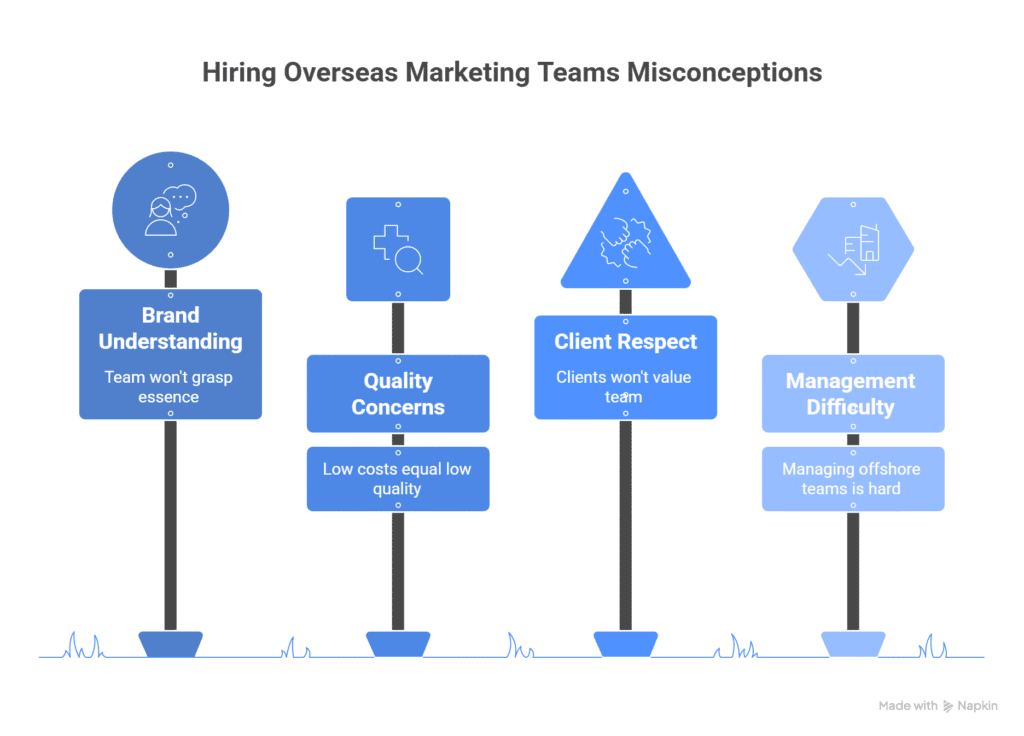Wondering about the reasons to hire a marketing team overseas? Choosing to build an international marketing department is all about building a stronger, leaner, and more scalable operation. Here are 5 practical advantages that make offshore hiring a strategic move for growth-focused businesses:
- Reduce Labor Costs Without Sacrificing Capability
- Access to Specialized Talent Without Location Limits
- Expand Operational Capacity With Time Zone Coverage
- Increase Output Without Scaling U.S. Headcount
- Improve Agility Through Flexible Team Structures
Nearshore and offshore marketing teams are no longer a workaround, they’re a competitive asset for companies serious about efficiency and speed. If you’re not considering this route, you may be missing the same levers your competitors are quietly pulling to grow faster and spend less. Keep reading to learn how to do it right.
1. Reduce Labor Costs Without Sacrificing Capability
Outsourcing marketing tasks to teams overseas can drastically lower expenses while maintaining high standards. Many businesses find this approach advantageous due to lower average salaries in various countries, leading to substantial savings.
Understand True Cost-to-Company: Salary, Overhead, and Tools
Calculate the total expense of hiring locally versus internationally. Assess salaries, which can be significantly lower in regions like North Africa or Eastern Europe due to differing living costs. Include overhead costs, such as office space and utilities, which may not apply to remote overseas teams.
Factor in marketing tools and software licenses, often available at reduced rates or included in packages offered by international teams.
How to Calculate ROI on Offshore vs. Domestic Hires
To evaluate the true return on investment (ROI) of hiring an offshore marketing team versus domestic employees, you need to go beyond payroll comparisons. ROI in this context means: Are you getting more output, revenue, or growth for every dollar spent on talent? Here’s how to break it down:
1. Define Your ROI Formula
Use the standard ROI formula:
ROI = (Net Profit / Total Investment) × 100
In this case:
Net Profit = Revenue directly attributable to marketing – Total cost of the team
Total Investment = Salary + Benefits + Tools + Training + Management overhead
You’ll do this calculation separately for your domestic and offshore teams.
2. Establish a Tracking Period
Set a fixed timeframe for comparison—typically 3, 6, or 12 months. This ensures consistency when comparing performance across both teams.
3. Assign Revenue Attribution or Lead Value
If direct revenue is hard to track, assign a value per marketing qualified lead (MQL) or customer acquisition. For example:
- Each MQL is worth $250
- Each new customer acquired is worth $2,000 in lifetime value
This allows you to link team output to financial return.
4. Track Performance Metrics
Monitor output and impact using quantifiable KPIs, such as:
- Number of leads generated
- Cost per lead (CPL)
- Website traffic growth
- Conversion rate improvements
- Campaign ROI or ROAS
- Content volume and quality
5. Calculate Total Cost of Each Team
Include the full loaded cost of each team:
- Salaries and benefits
- Recruitment costs
- Software/tools used
- Management time
- Taxes, workspace, or local compliance costs (for domestic hires)
Offshore hires usually come with lower base pay and fewer overheads, especially if hired through a staffing agency.
6. Compare ROI Side by Side
Run the ROI formula for both:
Example:
- Domestic Team: $100,000 cost ? $150,000 in revenue ? ROI = 50%
- Offshore Team: $55,000 cost ? $130,000 in revenue ? ROI = 136%
This tells you that even with slightly lower revenue, the offshore team delivered significantly higher returns per dollar spent.
7. Adjust for Contextual Variables
Consider factors that may affect performance:
- Time zone collaboration challenges
- Management complexity
- Cultural fit or communication gaps
- Onboarding and training ramp-up times
These can be quantified as time or efficiency losses if necessary.
A data-driven ROI comparison gives you more than a gut feeling—it lets you defend your hiring strategy with hard numbers. And if your offshore team is producing equivalent or better results for significantly less cost, you’re unlocking a compounding efficiency advantage.
If you’re not running these calculations, you’re making decisions in the dark.
Why Cost Savings Should Enable More Output, Not Less Quality
Common misconceptions suggest that lower costs lead to compromised quality. In reality, reducing expenses often allows you to expand your team or enhance your marketing budget.
Allocate savings toward better tools, more comprehensive campaigns, or additional training. You’ll not only maintain quality but might improve overall output by leveraging a diverse, skilled workforce that brings fresh perspectives to your marketing strategy.
2. Access to Specialized Talent Without Location Limits
Hiring an overseas marketing team gives you access to specialized skills that go beyond your local talent pool. This approach breaks geographical barriers, allowing you to find professionals who excel in areas that drive your business forward.
In-Demand Skills Found Abroad: Paid Media, SEO, Email Marketing, and More
Access global expertise in crucial marketing skills:
- Paid Media: Experts in paid media craft targeted ad campaigns that maximize ROI. They understand the nuances of different platforms like Google Ads and Facebook Ads. These professionals analyze data to optimize campaigns. This data-driven focus ensures your ads reach the right audience.
- SEO: Specialized SEO experts improve your website’s visibility on search engines. Their techniques include keyword research, on-page optimization, and backlink building. They stay updated on algorithm changes, ensuring your business maintains high rankings. Their insights can lead to increased organic traffic, boosting lead generation.
- Email Marketing: Talented email marketers excel in creating personalized campaigns. They segment audiences for tailored messaging, enhancing engagement rates. These professionals analyze open and click-through rates to refine strategies. Their skills contribute to effective customer relationship management, driving sales and retention.
Hiring overseas marketing teams equips you with a diverse set of skills. With the right talent, you transform your marketing efforts, leading to tangible growth for your business.
3. Expand Operational Capacity With Time Zone Coverage
Time zone coverage expands your operational capacity. It ensures marketing efforts run continuously.
Managing Split-Shift Teams Across U.S., Africa, and LATAM
Managing split-shift teams across the U.S., Africa, and LATAM creates strategic advantages. You gain access to diverse talent that operates during different hours. This setup allows your projects to progress around the clock.
You can set a schedule where one team hands off tasks to another as their workday ends. For example, while your U.S. team wraps up, your LATAM team starts, maintaining productivity. The key is clear communication.
Establish protocols that outline expectations and responsibilities. Use tools like Slack or Trello to keep everyone in sync across borders. This approach minimizes downtime and maximizes results.
Building Systems for Handoffs and Ownership Across Time Zones
Building systems for handoffs and ownership across time zones increases efficiency. Create documentation that details processes and expectations.
Checklists enhance consistency, ensuring everyone is aligned. You must also invest in collaboration tools that help real-time updates. Programs like Asana or Monday.com allow teams to track progress seamlessly.
Train your teams on these systems to foster accountability. Each member should understand their role in the handoff process. This system builds trust and reduces the likelihood of miscommunication. Empower your teams to take ownership of their tasks, ensuring smooth transitions.
The result?
A cohesive marketing strategy that operates without interruption.
4. Increase Output Without Scaling U.S. Headcount
You can boost productivity while keeping your U.S. headcount steady by hiring overseas marketing teams. This approach not only saves costs but also enhances output by tapping into a global talent pool.
You expand your capabilities without the burden of additional local hires, which often come with high expenses.
Pairing U.S.-Based Strategy Leads With Overseas Execution Pods
You can enhance your marketing strategy by pairing U.S.-based leads with overseas execution pods. Assign your local leads to oversee projects, ensuring they align with your overall goals.
Use the strategic insight of U.S. leads to inform your offshore teams, allowing them to deliver campaigns that resonate with your target audience. This collaboration merges local expertise with global execution, driving effective results.
Roles Best Suited for Offshore Execution: Graphic Design, Email Ops, SEM
You can benefit from specific roles best suited for offshore execution.
- Graphic Design: Specialized designers from countries with strong creative backgrounds offer innovative ideas. They create visually appealing materials, saving you time and resources.
- Email Ops: Skilled email marketers manage campaigns, segment audiences, and analyze results. Their expertise enhances your email marketing effectiveness without needing additional U.S. team members.
- SEM (Search Engine Marketing): Offshore SEM specialists bring knowledge of diverse markets. They optimize campaigns to increase visibility and drive targeted traffic, ensuring your marketing spend is efficient.
Leveraging these roles effectively improves productivity and lowers costs, allowing you to focus on strategic growth.
5. Improve Agility Through Flexible Team Structures
Hiring overseas marketing teams brings flexibility, enabling you to adapt quickly to changing market needs. This agility translates into enhanced project execution and experimentation.
Hiring Models: Contractor, Agency, or Embedded Offshore Team
Choosing the right model for your overseas marketing team impacts how efficiently you carry out strategies. Contractors offer specialized skills for short-term projects, making them perfect for testing new ideas.
Agencies provide comprehensive services, helping you run multiple campaigns simultaneously, while embedded offshore teams enhance collaboration and integration within your existing processes. Tailoring your approach to these models boosts responsiveness, allowing you to pivot when necessary.
Why Offshore Teams Reduce Fixed Costs and Increase Experimentation
Offshore teams often operate at lower fixed costs compared to domestic hires. This cost-effectiveness frees up the budget for experimentation. By investing in new strategies without significant financial risk, you increase opportunities to innovate.
You can allocate funds to test various approaches, gauge audience reactions, and refine your marketing efforts based on performance metrics. This iterative process, supported by skilled overseas teams, fosters a culture of experimentation that drives your business forward.
Debunking Common Misconceptions
Many assume hiring an overseas marketing team is fraught with issues. Let’s break down these misconceptions to see what really matters.

“They Won’t Understand Our Brand” ? How to Train Messaging and ICP
You fear that an overseas team won’t grasp your brand’s essence. The reality? You can train them effectively. Start by defining your ideal customer profile (ICP) and messaging guidelines. Share your brand story and values openly.
Use video calls for real-time discussions and feedback. Document key aspects in shared online folders. Detailed onboarding materials can bridge the gap, making your brand’s voice clear and easy to follow.
“Quality Will Drop” ? Why Output Depends on Process, Not Location
You worry that low costs correlate with low quality. Here’s the truth: output hinges on defined processes, not the team’s location.
Carry out clear standard operating procedures (SOPs) to maintain consistency. Regular check-ins ensure adherence to these processes. Use project management tools to track progress and deadlines. If your processes are solid, you won’t sacrifice quality, no matter where your team operates.
“Clients Won’t Respect Offshore Teams” ? The Brand Results Are What Matter
You might think clients won’t value an offshore team. Reality check: results speak volumes. Focus on delivering measurable outcomes. Showcase successful campaigns through case studies and data.
When your marketing improves, clients will respect the effort and skill behind the results. Don’t let the team’s location define perception; impact does.
“Too Hard to Manage” ? SOPs and Async Systems Fix This
You see managing offshore teams as a challenge. It doesn’t have to be. Set up well-defined SOPs and embrace asynchronous communication. Use platforms like Slack for daily updates and tools like Trello for project tracking.
When everyone knows their roles and workflows are clear, management becomes straightforward. Address concerns proactively; it bolsters trust and accountability.
How Scale Army Helps You Build High-Performing Marketing Team Overseas
Hiring an overseas marketing team can unlock significant potential for your business. By tapping into diverse skill sets and fresh strategic thinking, you can scale your marketing efforts while reducing costs. With the right structure, you’ll build a cohesive team that operates efficiently across time zones—keeping campaigns running smoothly, even while you sleep.
At Scale Army, we specialize in recruiting top-tier offshore marketing talent for U.S. businesses. From content marketers to paid media specialists, we help you assemble a high-performing team tailored to your growth goals.
The flexibility of international hiring allows you to respond faster to market shifts and reallocate resources with agility. Quality outcomes come from clear processes, strong communication, and the right hiring partner.
If you’re ready to scale smarter and spend more efficiently, book a free consultation with our team today.
Frequently Asked Questions
What are the main advantages of hiring an overseas marketing team?
Hiring an overseas marketing team offers access to diverse skills, innovative strategies, and cost-effective services. Businesses can leverage specialized talent and reduce labor costs significantly while enhancing their marketing efforts. This approach fosters a competitive edge in a global economy.
How can businesses calculate the cost-to-company for hiring overseas?
To calculate the cost-to-company for overseas hires, consider salaries, overhead, and necessary tools. For example, hiring domestically may cost around $65,000, while the average cost for overseas hiring is approximately $30,000, highlighting substantial savings.
Does hiring overseas teams compromise marketing quality?
No, hiring overseas teams does not compromise quality. With effective training and well-defined processes, businesses can achieve high-quality output. Investing savings into tools and resources can further enhance marketing efforts and outcomes.
How can businesses track ROI for offshore marketing hires?
Businesses can track ROI by measuring performance metrics like lead generation and customer acquisition costs. This helps assess the effectiveness of offshore hires compared to domestic teams, ensuring that the investment yields substantial returns.
What roles are best suited for offshore marketing execution?
Roles such as graphic design, search engine marketing (SEM), and email operations are ideal for offshore execution. These tasks enhance productivity while reducing costs, allowing U.S.-based teams to focus on strategic growth and high-level planning.
How can companies manage time zone differences with overseas teams?
To manage time zone differences effectively, companies should establish clear communication protocols and utilize collaboration tools like Slack or Trello. Documenting processes and having handoff systems in place can significantly enhance efficiency and accountability.
What flexibility do overseas marketing teams provide?
Overseas marketing teams offer flexibility in adapting to changing market needs. Various hiring models—contractors, agencies, and embedded teams—allow businesses to experiment with budgets and projects without significant financial risk.
How can businesses ensure effective training for overseas teams?
Effective training can bridge the gap in understanding brand messaging and customer profiles. Establishing standard operating procedures (SOPs) and using asynchronous communication tools can streamline training and enhance team productivity.




